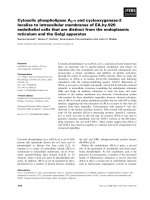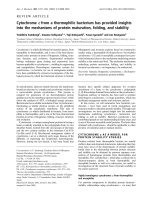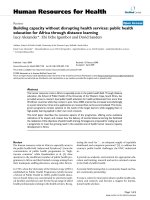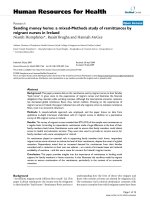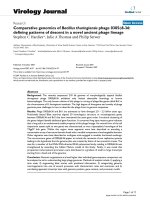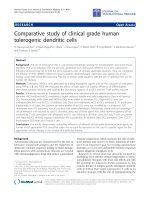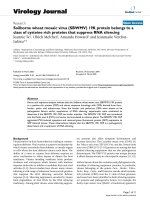Báo cáo sinh học: "Comparative embryology without a microscope: using genomic approaches to understand the evolution of development" potx
Bạn đang xem bản rút gọn của tài liệu. Xem và tải ngay bản đầy đủ của tài liệu tại đây (106.24 KB, 4 trang )
Garfield and Wray: Journal of Biology 2009, 8:65
Abstract
Until recently, understanding developmental conservation and
change has relied on embryological comparisons and analyses
of single genes. Several studies, including one recently
published in BMC Biology, have now taken a genomic approach
to this classical problem, providing insights into how selection
operates differentially across the life cycle.
It is an idea as old as the study of development itself:
embryos of different species are more similar during
earlier stages than later ones [1]. The first detailed des crip-
tions came from Karl Ernst von Baer, whose meticulous
observations of vertebrate embryos invented the field of
developmental biology. Although von Baer’s eponymous
‘law’ stating that early development is more conserved than
later development was formulated without an explicit
evolutionary context, Charles Darwin considered embryo-
logical similarity to be one of the most powerful forms of
evidence for common descent when he wrote the Origin of
Species. During the 150 years that have passed since that
momentous publication, embryologists have uncovered
numerous exceptions to von Baer’s generalization [2]. Yet
it remains true that early development is often remarkably
conserved among even distantly related species. Exactly
why this should be so remains unclear.
Alternative views of developmental constraint
One view is that developmental similarity is the result of
functional constraint, and thus maintained by negative
selection. The basic idea is that the processes of early
development influence many later processes, so functional
changes in genes underlying early development will
generally be deleterious because of extended pleiotropy
(Figure 1b, grey line). A variant promoted by Rudy Raff
and others [2] argues that constraint is highest somewhat
later in embryogenesis, when the adult body plan is laid
down (Figure 1b, black line). But the two views share at
their core the idea that there are points in development at
which the effects of mutations will have disproportionate,
and usually deleterious, consequences.
An alternative view is that conservation in early develop-
ment results from developmental ‘buffering’. Following the
pioneering work of Conrad Waddington, the argument is
that development is an inherently self-correcting process
that buffers the effects of variation early in the life cycle
more than later. As a result, mutations affecting genes
acting at some developmental stages are less likely to have
phenotypic consequences. This leads to the appearance of
conservation in early development despite a seemingly
paradoxical relaxation of constraint for developmental
genes expressed during conserved stages (Figure 1c).
A third view is that divergence in developmental programs
happens only when there is an adaptive reason. Walter
Garstang was among the first to argue that embryonic
development can readily evolve when ecological circum-
stances demand it. Conservation is common, he argued,
simply because embryonic development tends to happen
away from the influence of the environment (for instance,
within a uterus or an egg case), and is thus largely screened
from positive selection. In this view, it is patterns of
developmental divergence rather than conservation that
are most interesting (Figure 1d).
These three views offer strikingly different pictures of the
role that developmental changes have in origin of adap-
tations and organismal diversity. Discovering which view,
or more likely which combination, best explains patterns of
conservation and divergence in development is central to
understanding the origins of animal diversity.
Taking it to the genome
The advent of genome-scale datasets provides an exciting
new approach for evaluating these views. This approach,
which has now been applied in several studies [3-7], begins
with measurements of transcript abundance throughout
the genome (based on microarray or expressed sequence
tag (EST) data) for several stages of development taken
from one or (ideally) more species. Next, for each gene for
which orthology can be confidently determined, the ratio
of non-synonymous (dN) to synonymous (dS) substitutions
Minireview
Comparative embryology without a microscope: using genomic
approaches to understand the evolution of development
David A Garfield and Gregory A Wray
Address: Biology Department and Institute for Genome Science & Policy, Duke University, Durham, NC 27708, USA.
Correspondence: David Garfield. Email: Gregory Wray. Email:
65.2
Garfield and Wray: Journal of Biology 2009, 8:65
between each species is calculated as a proxy for functional
divergence relative to the underlying mutation rate. One
can then search for differences in the average value of dN/dS
for genes expressed at different stages of development, and
test for stage-specific patterns of positive selection (dN/dS >1),
negative selection (dN/dS <1), or drift (dN/dS = 1) pre-
dicted by the different views (Figure 1).
A recent study by Artieri et al. [3] is among the largest of
this kind so far. It makes use of EST data from three
developmental stages of Drosophila melanogaster (embry-
onic, pooled larval/pupal, and adult), sequence data from
five species in the melanogaster subgroup, and thousands
of randomly selected genes to examine how selective
constraint changes as a function of developmental time.
The results are intriguing: whereas genes expressed pri-
marily in adults show some evidence of positive selection,
genes classified as embryonic seem to be under strong
negative selection, suggesting both that early development
is highly constrained (the first viewpoint mentioned above;
Figure 1b) and that adult adaptations are primarily the
result of genes acting in adults (the third viewpoint; Figure 1d).
Similar studies in nematodes [4,5] and vertebrates (zebra-
fish and mice [6]) failed to find differences in average dN/dS
values at different points in embryonic development,
whereas a previous study in Drosophila [7] found evidence
for significantly stronger constraint (low dN/dS) among
genes expressed in late embryogenesis than those
expressed earlier in development or later in pupae or
adults. These discrepancies suggest that differences in the
modes of development used by these three taxa have
evolutionary consequences. Two of the studies [4,6] also
found evidence that selection on copy number variation
Figure 1
Expected relationships between developmental divergence and the strength of selection. (a) Two potential patterns of conservation at the
level of embryonic development. The grey line represents the classical pattern of early developmental conservation described by von Baer
with the earliest stages of development being more constrained than later stages. The black line shows the ‘hour-glass’ pattern of
conservation described by Raff [1]. (b-d) Three predictions about the relationship between these patterns of divergence and natural selection
(see text). Grey and black lines show, respectively, the action of natural selection acting on the genome at different times during development
under von Baer’s and Raff’s models of embryological divergence and constraint. (b) Constraint results from negative selection on
developmental variation. (c) Developmental buffering results in relaxed constraint on highly buffered developmental stages. (d) Divergence in
development is the result of adaptation.
Developmental divergence
Positive selection
Neutral evolution
Negative selection
Developmental time
Strength of selection during development
Developmental time Developmental time
Extreme divergence
Moderate divergence
Conservation
(c)(b) (d)
(a)
Developmental time
65.3
Garfield and Wray: Journal of Biology 2009, 8:65
was stronger for genes expressed early in development,
suggesting that changes in gene expression levels may
disproportionately affect early development (a topic to
which we return later). In addition, with one exception [4],
the studies all found that genes expressed primarily in adults
showed less evidence of constraint and more evidence of
positive selection than genes expressed in earlier stages. In
each case this particular trend was driven by positive
selection acting on genes expressed specifically in testes.
Challenges and future directions
Although these genome-scale analyses [3-7] are beginning
to provide insights into the action of selection across
development, the approach faces several challenges. One is
that expression levels of many regulatory genes rise during
development, whereas ‘housekeeping’ genes are more
constant. As a result, early development can appear to be
enriched for housekeeping genes, such as those required
for mitosis. Housekeeping genes are, not surprisingly,
highly conserved; this can result in a misleading picture of
conservation in very early development, as one study has
pointed out [6]. Similarly, failing to correct for testis-
specific genes can lead to a false impression, because
positive selection on these genes is probably driven by
sperm competition rather than stage-specific differences in
selection per se.
Published studies have considered species with relatively
similar ecologies and life-histories, a limitation imposed by
the fact that the current genome projects on model
organisms cover a restricted phylogenetic distribution.
However, it has long been clear that early development can
differ enormously among even closely related species [8].
Understanding these exceptions to the conservation of
early development poses an important challenge. Cases of
extreme divergence in early development are generally
interpreted as adaptations driven by changes in life
histories; such as modification in embryonic nutrition,
altered larval dispersal and defense mechanisms, or by
changes in the embryonic environment. Investigating how
environmental factors drive the evolution of early
development is now possible as new technologies bring
genome-scale sequence and expression data from virtually
any organism within reach. One possible approach involves
comparing species with differ ent life histories or inhabiting
different environments (Figure 2). Parallel changes in
developmental divergence and conservation along
branches leading to evolutionarily derived life histories can
provide a deeper understanding of the role that adaptation
has in shaping development.
Another important challenge arises from the fact that
natural selection can operate on noncoding as well as
coding sequences. Indeed, it is in the noncoding regulatory
sequences around each gene that we might expect to find
an important part of the genetic basis for divergence in
expression among species. All the studies published so far
have contrasted selection on coding sequences with gene
expression across the life cycle. Methods now exist to test
for selection in noncoding sequences [9], opening the door
to analyses that incorporate selection on regulatory
elements. This could provide insights that might be missed
by analyses that consider only coding sequences.
These are exciting times for evolutionary biologists, as
genome-scale datasets are applied to an ever-expanding
range of problems. Understanding how and why natural
selection operates differentially across development is
among the first instances in which sequence and functional
comparisons across the genome have been brought
together to address a classical problem in evolutionary
biology. The studies carried out so far [3-7] highlight some
intriguing trends, especially concerning the potential
impacts of changes in gene expression during early
development. But this is just the beginning. Although there
are some thorny technical problems that need to be
addressed, the real promise lies in applying genome-scale
data to a much wider range of species contrasts. How does
the genome-wide distribution of selection across develop-
ment change when closely related species occupy very
different habitats or differ markedly in their life history?
Sampling a wider range of species comparisons may solve
one of the oldest conundrums in evolutionary develop mental
Figure 2
Exploring the effects of changes in life history on development. The
lineages in red show two independent shifts to lecithotrophic
development (in which the larva does not feed and thus has a much
simpler morphology) in euechinoid sea urchins as a result of
increases in maternal contributions [1,7]. By comparing convergent
changes along the red lineages with those along the black lineages,
we can get a sense of the ways in which changes in maternal
contribution influence the evolution of development at a genetic level.
Larva Adult
65.4
Garfield and Wray: Journal of Biology 2009, 8:65
biology: why development is so often conserved across vast
phylogenetic gulfs and yet sometimes specta cu larly
diverged among closely related species.
References
1. Richards RJ: The Meaning of Evolution: the Morphological
Construction and Ideological Reconstruction of Darwin’s
Theory. Chicago: University of Chicago Press; 1992.
2. Raff RA: The Shape of Life: Genes, Development, and the
Evolution of Animal Form. Chicago: University of Chicago
Press; 1996.
3. Artieri CG, Haerty W, Singh RS: Ontogeny and phylogeny:
molecular signatures of selection, constraint, and tempo-
ral pleiotropy in the development of Drosophila. BMC
Biology 2009, 7:42.
4. Castillo-Davis CI, Hartl DL: Genome evolution and develop-
mental constraint in Caenorhabditis elegans. Mol Biol Evol
2002, 19:728-735.
5. Cutter AD, Ward S: Sexual and temporal dynamics of
molecular evolution in C. elegans development. Mol Biol
Evol 2005, 22:178-188.
6. Roux J, Robinson-Rechavi M: Developmental constraints on
vertebrate genome evolution. PLoS Genet 2008,
4:e1000311.
7. Davis JC, Brandman O, Petrov DA: Protein evolution in the
context of Drosophila development. J Mol Evol 2005, 60:
774-785.
8. Wray GA: The evolution of embryonic patterning mecha-
nisms in animals. Semin Cell Dev Biol 2000, 11:385-393.
9. Haygood R, Fedrigo O, Hanson B, Yokoyama KD, Wray GA:
Promoter regions of many neural- and nutrition-related
genes have experienced positive selection during human
evolution. Nat Genet 2007, 39:1140-1144.
Published: 21 July 2009
doi:10.1186/jbiol161
© 2009 BioMed Central Ltd
